
Hyperolius acutirostris is a species of frog in the family Hyperoliidae. It is endemic to southwestern Cameroon, found as far east as the region of Yaoundé. Common name sharpsnout reed frog has been coined for it.
Hyperolius bolifambae is a species of frog in the family Hyperoliidae. It is known from southeastern Nigeria, southern Cameroon, and southwestern Central African Republic, with an isolated record in northeastern Democratic Republic of the Congo ; the latter record may be considered doubtful. It likely has a broader range towards south and east than currently documented, and the AmphibiaWeb includes Gabon and the Republic of the Congo in the distribution.
Hyperolius brachiofasciatus is a species of frog in the family Hyperoliidae. It is known from its type locality, Ngoto in southwestern Central African Republic, from another locality in central Republic of the Congo, and from a number of localities in central Democratic Republic of the Congo. However, as of 2014, IUCN SSC Amphibian Specialist Group considers records other than the one from the type locality erroneous, and that this species likely is a synonym of some other species. Common name Ngoto reed frog has been proposed for it.
Hyperolius camerunensis is a species of reed frog in the family Hyperoliidae. It is endemic to western and southwestern Cameroon.

Hyperolius concolor, also known as the variable reed frog or Hallowell's sedge frog, is a species of frog in the family Hyperoliidae. It occurs in West and Middle Africa.
Hyperolius diaphanus is a species of frog in the family Hyperoliidae. It is endemic to the eastern Democratic Republic of the Congo and is known from near the Itombwe Mountains and the mountains to the west of Lake Kivu. Limits of its range are not clear and might extend into the adjacent Burundi and Rwanda. Common names Kigulube reed frog and translucent reed frog have been proposed for this species.
Hyperolius dintelmanni is a species of frogs in the family Hyperoliidae. It is endemic to Cameroon and found in the montane southwestern part of the country. Specifically, it has been recorded from the Bakossi Mountains, including the Edib Hills and Mount Kupe. The specific name, dintelmanni, honors Mr. Horst Dintelmann from Germany in recognition of "his support of taxonomic research and forthcoming conservation projects in Cameroon".
Hyperolius frontalis is a species of frog in the family Hyperoliidae. It is found in the eastern Democratic Republic of the Congo, from northwest of Mount Rwenzori, south to west of Lake Kivu, extending into extreme south-western Uganda in the Bwindi Forest. Common names Bushoho reed frog and white-snouted reed frog have been coined for this species.
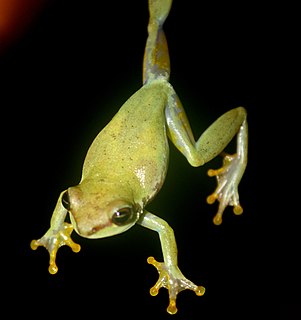
Hyperolius fusciventris is a species of frog in the family Hyperoliidae. It occurs in West and Middle Africa between Sierra Leone in the west and western Cameroon in the east. Common name lime reed frog has been coined for this species.
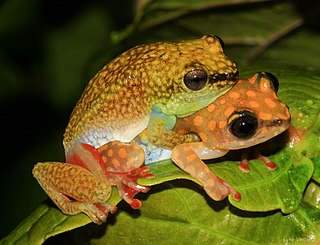
Hyperolius guttulatus is a species of frog in the family Hyperoliidae. It occurs in West and Middle Africa between Sierra Leone in the west and Gabon in the east/south. Common name dotted reed frog has been coined for this species.
Hyperolius hutsebauti is a species of frog in the family Hyperoliidae. It is endemic to Democratic Republic of the Congo north of the Congo River, although the actual limits of its distribution are unclear. The specific name hutsebauti honours Franz Joseph Hutsebaut (1886–1954), a Catholic missionary in what was then Belgian Congo. Common name Ibembo reed frog has been coined for it.
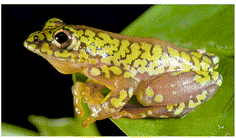
Hyperolius minutissimus is a species of frog in the family Hyperoliidae. Its common names are tiny reed frog and dwarf reed frog. It is endemic to Tanzania and known from the Udzungwa Mountains and from near Njombe in the Southern Highlands.

Hyperolius mitchelli is a species of frogs in the family Hyperoliidae. It is found in the area between northeastern Tanzania, Malawi, and central Mozambique.
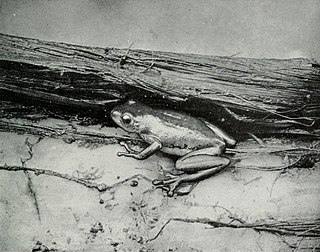
Hyperolius picturatus is a species of frog in the family Hyperoliidae. It is found in northern and eastern Sierra Leone, southern Guinea, Liberia, Ivory Coast, and Ghana; its range might extend to Togo. Common names coined for this species are Tanzania reed frog and variable montane sedge frog.
Hyperolius soror is a species of frog in the family Hyperoliidae. It is endemic to Guinea as it is known with certainty only from Nzérékoré in the southern part of the country, although it is likely that it occurs in adjacent Liberia and western Ivory Coast. Common name soror reed frog has been coined for this species.

Hyperolius spinigularis is a species of frog in the family Hyperoliidae. It is found in the Mulanje Massif in southern Malawi and the Namuli Massif in adjacent Mozambique. Records from Tanzania refers to other species. Males of this species have characteristic small spines during the breeding season. Its common names are spiny-throated reed frog, spiny reed frog, and Mulanje reed frog.
Hyperolius sylvaticus is a species of frog in the family Hyperoliidae. It is found in southern Ivory Coast, Ghana, Togo, Nigeria, and western Cameroon, with a gap in Benin. It is also likely to occur in Liberia. Common name Bobiri reed frog has been coined for this species.

Hyperolius tanneri is a species of frogs in the family Hyperoliidae. It is endemic to the West Usambara Mountains in northeastern Tanzania. Common name Tanner's reed frog has been coined for this species.
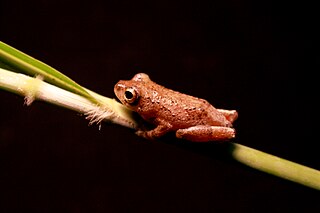
Hyperolius tuberculatus is a species of frog in the family Hyperoliidae. Its common name is rainforest reed frog. It ranges from the southeastern Nigeria to the Central Africa in Cameroon, western Central African Republic, Equatorial Guinea, Gabon, Republic of the Congo, and Democratic Republic of the Congo. It is also likely to occur in the Cabinda enclave of Angola.
Hyperolius vilhenai is a species of frog in the family Hyperoliidae. It is only known from its type locality, Cuílo, along the Luita River in northern Angola, although it is likely to occur in adjacent Democratic Republic of the Congo. Additional specimens from the Cangandala National Park have been provisionally assigned to this species. The specific name vilhenai honours Ernesto Jardim de Vilhena, a Portuguese naval officer, politician, and businessman. Common names Luita River reed frog and Vilhena's reed frog have been proposed for this frog.










